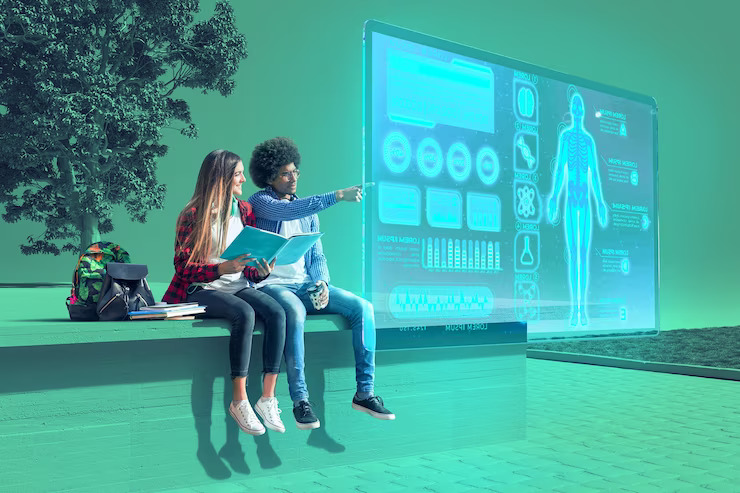How AI Is Transforming the Fashion Industry
The fusion of fashion and technology has always driven the industry forward, but the recent integration of artificial intelligence (AI) is ushering in a transformative era like never before.
AI In Fashion Industry
As a realm characterized by its flair, dynamism, and vibrancy, the fashion industry is increasingly leveraging AI to reimagine traditional processes, elevate consumer experiences, and even redefine the boundaries of creativity. This ongoing metamorphosis is not merely a technological evolution but a holistic reinvention. In this piece, we’ll delve into the myriad ways AI is reshaping the fashion domain.
Inventory Management and Demand Forecasting

Every retailer faces the daunting challenges of overstocked shelves and the contrasting issue of missed sales opportunities from stockouts. While AI, with its impressive data-processing capabilities, presents a promising solution to these problems, it’s essential to remember that it is still an evolving technology.
For instance, AI models can sometimes overfit historical data, resulting in predictions that aren’t generalizable to new scenarios. They can also be sensitive to the quality and relevance of the data they’re trained on, making them vulnerable to garbage-in-garbage-out pitfalls. In addition, understanding and tuning these systems requires expertise, which not every retailer may possess. Given these limitations, it’s not always advisable to hastily substitute established solutions. Systems such as apparel ERP software, which have proven their reliability over time, shouldn’t be quickly sidelined.
In some cases, integrating AI with such established solutions might be the best approach, balancing the strengths of both.
Personalized Shopping Experiences
Remember the days when shopping online was a game of guesswork? Those days are behind us. Today, AI-driven recommendation engines are revolutionizing the online shopping experience. By understanding and learning from each customer’s behavior and preferences, AI can suggest items that the shopper is more likely to purchase.
This isn’t merely about pushing products. It’s about creating a curated experience for every individual, ensuring that shopping online feels just as personal and tailored as walking into your favorite boutique.
Design and Trend Prediction

The fashion world has always been about predicting the next big trend. Now, AI is stepping into the role of the oracle. By analyzing vast swathes of online data, from social media mentions to online searches and e-commerce metrics, AI algorithms can spot patterns.
These patterns, often subtle and unnoticed by the human eye, indicate what the next fashion wave might be. Designers and brands can then get a head start by crafting collections that resonate with future market demands.
Virtual Try-Ons and Augmented Reality
Physical fitting rooms are getting a digital counterpart. Thanks to AI and augmented reality, consumers can now virtually try on outfits from the comfort of their homes. This isn’t just about superimposing a dress or shirt onto a digital image of the customer. The technology has advanced to understand body shapes, sizes, and how different fabrics fall, ensuring that the virtual try-on is as close to reality as possible.
This has benefits galore. Retailers reduce returns because customers have a better sense of fit before purchasing, and shoppers enjoy a seamless and interactive buying journey.
Sustainable Fashion and AI

Sustainability isn’t just a buzzword; it’s an imperative. As the fashion industry grapples with its environmental footprint, AI comes to the rescue. By monitoring supply chains, AI can ensure that materials are sourced ethically and sustainably. It can track production processes to minimize waste and ensure energy efficiency. For consumers increasingly concerned about the planet, this AI-driven transparency offers assurance that their fashion choices are not at odds with their ecological values.
Quality Control and Assurance
Fashion is as much about aesthetics as it is about quality. Brands know the cost of a defective product, both in terms of returns and reputation. Enter AI. With machine learning and visual recognition, AI can inspect textiles and finished products, spotting defects that might escape the human eye. This ensures that every item that reaches the consumer meets the brand’s stringent quality benchmarks.
Chatbots and Customer Service

Ever had a burning question while shopping online, only to abandon your cart because there was no one to answer it? You’re not alone. More than 70% of online shopping carts are abandoned before purchase. AI-driven chatbots are changing that narrative.
Operating 24/7 on fashion e-commerce platforms, these chatbots offer instant support. Whether it’s about size queries, fabric details, or shipping times, these AI assistants provide real-time answers, directly addressing one of the key reasons for cart abandonment and enhancing the customer’s shopping experience.
Final Thoughts
AI’s impact on the fashion industry is profound. From back-end operations to front-end customer experiences, this technological marvel is setting the stage for a more efficient, responsive, and innovative fashion world. As we look ahead, it’s clear that the intertwining of fashion and AI is not just a fleeting trend but the future of the industry. Stay updated, stay informed, and embrace the digital future of fashion.

















